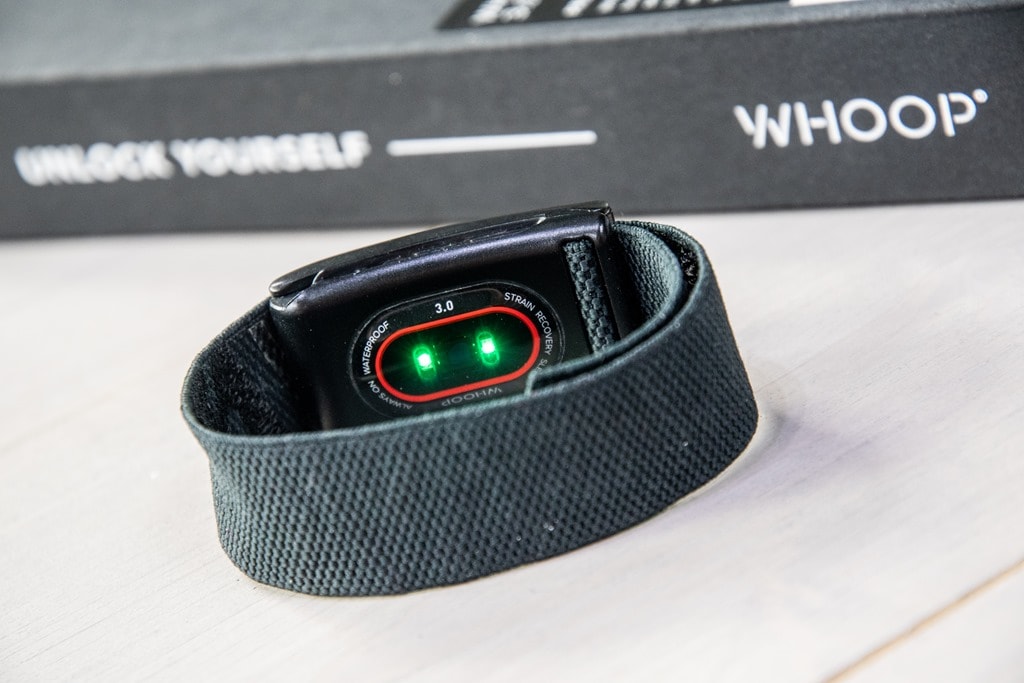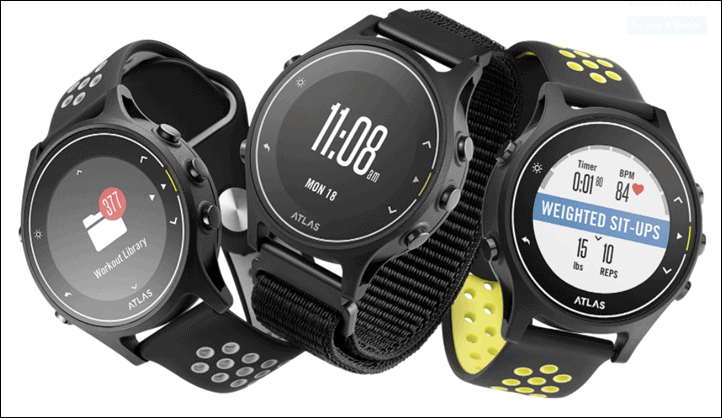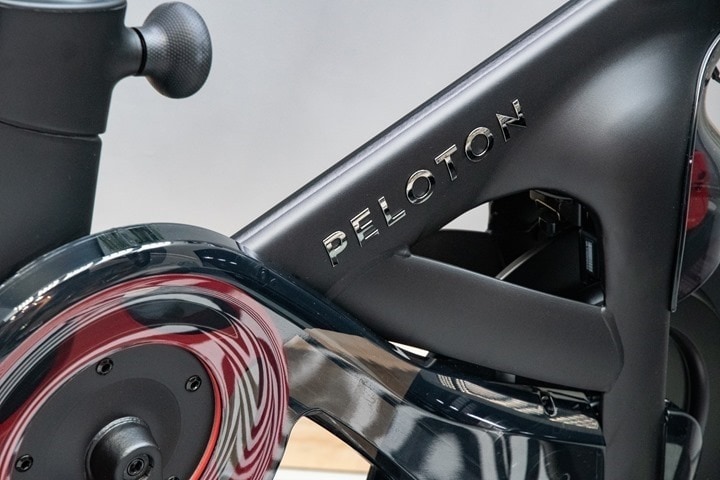Peloton has been quietly acquiring various companies over the past half a year, some three of which were mentioned in their latest quarterly filing – however, only one was by name. The rest remain unnamed. But this week, two companies have been confirmed. The first being Atlas Wearables, and the second being a smart yoga/workout mat company, Otari.
Now Atlas Wearables has been around the block a surprisingly long time for a wearable company you probably haven’t heard of. I first covered their Kickstarter campaign some 7 years ago in 2014. And each year at CES I’d usually see them around.
Much of the focus of their devices was on the gym front, rather than the wider endurance sports realm, you can see an older review here of their Atlas Wristband 2. Given the gym focus isn’t typically my jam, it wasn’t something I tended to cover. More recently they’ve started to focus more on algorithms and integration – which is probably why Peloton is interested. They’ve been rumored to be working on some sort of strength training device. And algorithms related to what would make sense, as would acquiring a company that focused on strength training.
However, I’d be extremely skeptical if Peloton were to get into the watch game themselves. See, while Peloton dominates the indoor cycling realm, that’s a relatively small market. Peloton’s most recent filing illustrates why. They have 1.98M (1,980,000) Peloton bikes/treadmills in homes today (plus 625K digital subscribers), and while that’s a lot – for comparison, Fitbit generally sells between 15-20 million devices *per year*. Apple sells between 30-40 million units per year (and growing fast). Garmin is a bit of an unknown here, but my guess is between 2 and 6 million devices per year.
Anyway, the point here isn’t about the others – it’s more of a numbers game. Undoubtedly, the vast majority of Peloton users likely already have a smart wearable of some sort, and making successful wearables is incredibly difficult and requires many years and a large user base to test against. That’s because people are often rather finicky on what I call 1% features. Meaning, a feature that to you is “the most important thing ever, how can a watch not have this”, yet to me is “shrug, never heard of it”. It’s a similar problem to why bike computers are so hard. Everyone has their routines, and changing them is tough.
However, I’d argue a *far* smarter twist for Peloton here is to roll-out a Whoop style tracking band. Keep it low-key, discrete, and non-competitive with the Apple Watch that many Peloton users might be wearing. As long as the optical sensor isn’t a dumpster fire, Peloton could do really well here in a subscription service that targets both Peloton and non-Peloton users alike, while acting as a gateway to the platform as a whole.
For those not familiar with Whoop, it essentially aims to track only two things: Recovery (via sleep), and strain (your workouts, aka training load). That’s it, no step tracking, no screen, no notifications. Its app/platform interface is great, the potential insights fantastic, but its sensor is so horrific it makes the data largely worthless.

If Peloton were to tie a band like that with their platform/app for live movement tracking using patents from Atlas – that’d do exceedingly well, and also be saleable to non-Peloton Bike/Treadmill owners. Whereas building out a full-fledged smartwatch means running up against all the expectation baggage that comes with making a smartwatch. Notifications, apps, music, full activity tracking, reporting, dashboards, baseline watch functionality and tons more. Just start pressing buttons on your smartwatch right now and think to yourself: Everything I see here, they have to build to a Peloton-acceptable level.
Versus a band that’s just a pile of algorithms and a good optical sensor? They’ve already got that IP with the acquisition. Plus, it’d have the upsell benefit of acting as a heart rate sensor for your bike/app live – one more easy selling point when pushing people over the edge. And Atlas already has sleep tracking, activity tracking, stress tracking, RHR and HRV tracking – essentially, all the baselines for the perfect no-screen band.
In any case – interesting times ahead indeed, thanks for reading!
FOUND THIS POST USEFUL? SUPPORT THE SITE!
Hopefully, you found this post useful. The website is really a labor of love, so please consider becoming a DC RAINMAKER Supporter. This gets you an ad-free experience, and access to our (mostly) bi-monthly behind-the-scenes video series of “Shed Talkin’”.
Support DCRainMaker - Shop on Amazon
Otherwise, perhaps consider using the below link if shopping on Amazon. As an Amazon Associate, I earn from qualifying purchases. It doesn’t cost you anything extra, but your purchases help support this website a lot. It could simply be buying toilet paper, or this pizza oven we use and love.
























Could they incorporate the Atlas algorithms in their Apple Watch app and build out functionality on top of Apple WatchOS or do you think it’s better to have separate hardware?
Exercise equipment, body sensors, smart jewelry, classes, diet & food….and then a proprietary network to lock in all your data, right?
You do seem to miss some of the loyalty that Peloton users have. For instance, bike computers may be hard, but everyone who has a Peloton bike essentially has one from Peloton (with a very large screen). Imagine if you could get the “full” Peloton experience from a digital subscription if you bought a Peloton watch, including live syncing of your stats like a bike user. Possibly even more if they are doing something with strength training. Hmm, this sounds like something another company is doing, only they started with the watch first 😉.
That’s true, that would be an appealing segment from the watch/wearable, to get more stats in the app.
On a side note – your link about Atlas Wristband campaign was a nice trip to the past with app updates screenshots and even a Windows Phone (!) app update screenshot!
Haha…blasts for the past are fun!
Oh CES…
Slightly off-topic: I am trying the pellethon app plan with my Tacx Neo smart. What is the best way to control the trainer while watching the pelethon classes? The Garmin Edge device or is there a good app for it? How does the pelethon resistance ratings (e.g 80 %) translate to ftp based zones?
Ask and you shall receive!
So, this site takes all the Peloton Power Zone workouts, decodes the zones/timings, and then allows you to export it as a structured workout file for import into Zwift (or other platforms). I haven’t tried it, but, would be curious how it goes.
The site: link to app.homefitnessbuddy.com
There goes my dream of an pelton+Garmin+zwift roll up…
Love the band idea. I’ve secretly been wishing Apple would come out with the “AppleBand” as an alternative to the watch. To let folks who prefer the Garmin/other watch’s still tie into the Apple fitness community. I think a good number of data junkies would love a band that doesn’t distract them all day with notification, emails, etc, but still feeds into the communities.
Indeed, that would be super interesting!
Not sure there would be much attraction for digital subscribers to buy another watch. I have a Garmin cadence sensor on my Schwinn spinning bike, and I use a Polar OH-1. Both numbers display on the Peloton app on my iPad. I wear my 945 connected to a MyZone chest strap to monitor heart rate zones. It works flawlessly.
I agree for a ‘watch’ – very low chance of converting digital app people.
However for a wearable band, I think the attraction is much like Whoop – whereby people still wear regular watches on the other wrist.
Peloton, Atlas, Otari, … Who is it?!?! :D
I’d love an Apple or Peloton wareable, especially one that is more discreet (and more accurate, obviously) than my Whoop. I still wear a traditional watch in non-exercise settings, so my ability to have an all-day tracker that doesn’t have another screen and that still works in a business casual (non-COVID) setting is pretty limited. If Garmin could develop a ring, or Oura provide more Whoop-like features, I would be in. Or if Apple or Peloton come up with something that is akin to an original Fitbit or Jawbone in size, I think there would also be a market. I agree, Ray, that if Peloton is able to market its wareable as the HR device to use with its bike (sell it as a package, and market some additional features beyond the HR such that it’s a viable upgrade over the strap) or the app, there is a market here.
Looks like you may have missed a couple of other acquisitions –
Precor
Otari Studio (creators of the Otari Mat)
Aiqudo
Peerfit
I’ve talked about some of those in the Week in Review posts as they’ve come up. Some of them I didn’t honestly think merited a longer post.
Who handles the wearable app now?